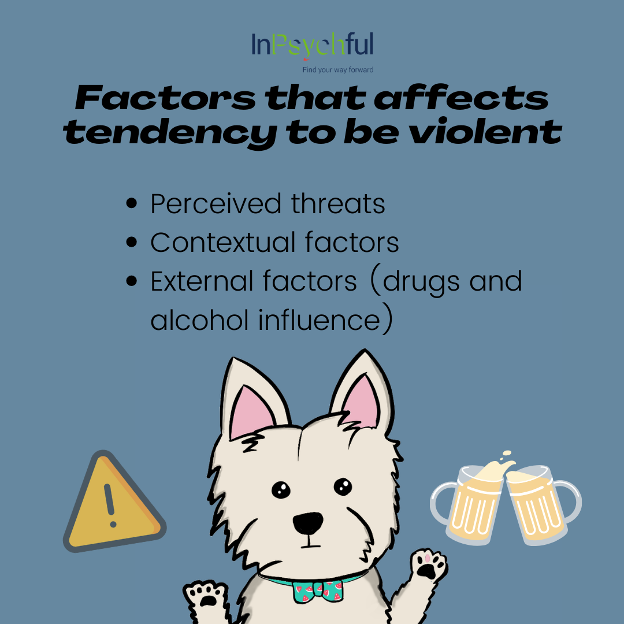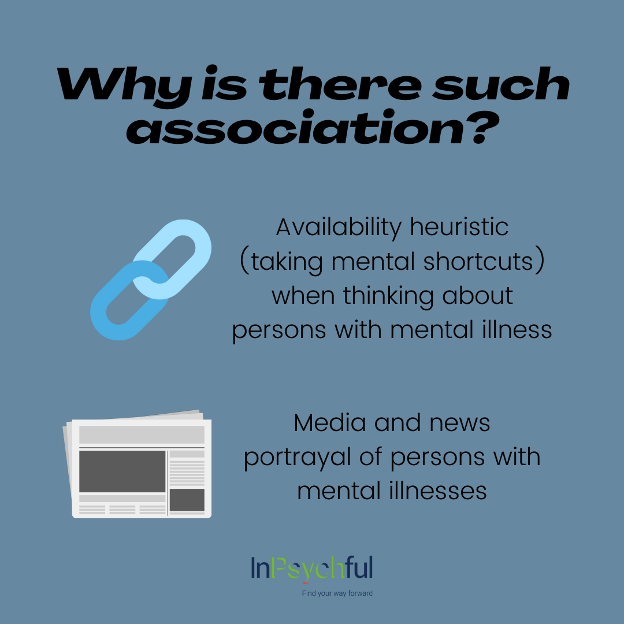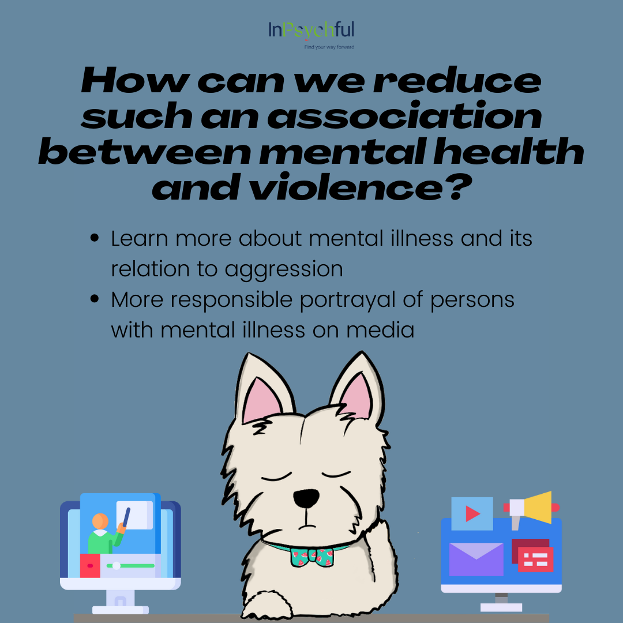In view of the recent cases in Singapore, the spotlight has been cast on mental health and its relation to violent behaviours in individuals. You may be asking, are persons with mental illness dangerous? This article aims to answer these questions that you may have.
What is violence?
According to the World Health Organisation (2021), violence is “the intentional use of physical force or power, threatened or actual, against oneself, another person, or against a group or community, that either results in or has a high likelihood of resulting in injury, death, psychological harm, maldevelopment, or deprivation.” There are two types of aggression, proactive and reactive. Reactive aggression is a response to a threat, with the objective being to remove the provoking situation (Wrangham, 2018). On the other hand, proactive aggression involves planning a purposeful attack with internal or external rewards as a goal (Wrangham, 2018).
Is it true that people with mental illness have the tendency to become more violent?
You may be wondering, does mental illness lead to violence? In the past, it was believed that mental illness overrides self-control, causing violent behaviours (Hiday, 1997). Although psychotic symptoms were being considered as one of the factors, it was found that these symptoms are not linked to violence. Instead, it is found that violence in persons with mental illness is linked to feelings of personal threats. Behaviour control is more likely to be overridden when an individual believes that he or she is vulnerable to danger by others (Hiday, 1997).
Other factors that may influence such behaviours involves the individual’s situation. Contextual factors such as divorce, separation, financial issues may foster violence and loss of control (Elbogen et al, 2016). Tension may possibly arise between a person with mental illness and others as symptoms of mental disorder appears (Hiday, 1997). Unconventional behaviours can lead to tension, as others make fun of them or try to stop the individual from performing the uncontrollable action (Hiday, 1997). When there is a lack of understanding between the two parties, this can escalate anger, and may eventually lead to physical aggression and behaviours (Hiday, 1997).
Furthermore, external factors such as alcohol and drug intoxication increases the likelihood of committing violent acts (Elbogen et al, 2016). Additionally, it was found that dual diagnosis of mental illness and substance abuse has been suggested to increase risk for violence (Mulvey, 1994).
It is clear that mental health conditions do not inherently cause violence, rather, we need to consider other factors in the person’s context that contribute to aggressive actions by an individual. Importantly, individuals with mental illness do not pose an increased risk of violence compared to the general population when appropriately treated (Rueve & Welton, 2008).
Why is there such association?
When a person with mental illness engages in a violent action, there is a tendency to assume that others with similar disorders will do the same, while ignoring all the other individuals who have never been violent (White, 2021). This is also known as the availability heuristic, which is a common mental shortcut that people take when making a decision. In other words, we rely on information that comes to our minds quickly and make a decision based on that information (Cherry, 2020). However, this is troubling in the context of mental illnesses and its association with violence, as it contributes to the stigma in persons with mental disorders.
Furthermore, the media tends to sensationalise occurrences regarding violence and murders by persons with mental disorders (Srivastava, 2018) and it is inevitable that these perpetuates the stigmatization of individuals with mental illnesses. According to Srivastava et al. (2018), for those with no actual experience with person with mental illness, individuals rely on what they observe on the media for their perception of individuals with mental disorder. This ignores the fact that most violence in the society is carried out by individuals without mental illness (Varshney, 2016). Such portrayal of persons with mental illness as being aggressive, violent, unpredictable, and brutal misrepresents these individuals and is inaccurate (Srivastava et al.,2018). Such augmented perceptions contribute to the stigma towards persons with mental disorders which contributes to reduction in help seeking and disclosure of mental illnesses (Varshney, 2016).
How can we reduce such an association between mental health and violence?
According to Ong (2020), current efforts to end the stigma of mental illness is only scratching the surface of discriminatory acts and microaggression that individuals with lived experiences of mental health conditions face. With the proliferation of social media and the ability to leave opinions online anonymously, it seems like comments that ridicule individuals who acted in a peculiar manner perpetuates these misunderstanding of persons with mental disorder (Ong, 2020). This fuels the idea that people with poor mental health are “crazy individuals” who behaves weirdly (Ong, 2020).
You can dive deeper into learning more about mental illnesses and share this knowledge with those around you. By reading this blog post, you’ve now learnt a bit more about mental illnesses and violence and is one way to reduce stigma. You are now able to share this knowledge within your circle. Also, be careful with your use of language, refrain from using mental health conditions as adjectives to describe persons with mental illnesses.
Srivastava et al. (2018) suggests that good media reporting helps the community understand and the experience of mental illness better through including the perspectives of people mental illness, carers, and mental health workers and encourage help-seeking behaviour.
Ultimately, it is untrue persons with mental illness are violent and it helps to consider other factors that contributes to a person’s violent behaviour, rather than just the mental illness that the person is struggling with.
Camellia Wong, MA., Tan Khai Teng
More Articles
I am Asian and Emotionally Distressed. Am I allowed to seek help for my problems?
Understanding Stigmatization in Singapore Around Mental Illness
Stuck at home and in the closet: COVID for the Queer individual (Social isolation/ Mental Health)
Reference
Elbogen, E. B., Dennis, P. A., & Johnson, S. C. (2016). Beyond mental illness: Targeting stronger and more direct pathways to violence. Clinical Psychological Science, 4(5), 747–759. https://doi.org/10.1177/2167702615619363
Greenstein. L, (2017, Oct 11). 9 Ways to Fight Mental Health Stigma. National Alliance on Mental Illness.https://www.nami.org/blogs/nami-blog/october-2017/9-ways-to-fight-mental-health-stigma
Hiday, V. A. (1997). Understanding the connection between mental illness and violence. International Journal of Law and Psychiatry, 20(4), 399–417. https://doi.org/10.1016/S0160-2527(97)00028-9
Mulvey, E. P. (1994). Assessing the evidence of a link between mental illness and violence. Psychiatric Services, 45(7), 663–668. https://doi.org/10.1176/ps.45.7.663
Ong, A. (2020, 12 May). Commentary: We declare a goal of ending mental health stigma yet viciously mock the woman at Shunfu Market. Channel News Asia. https://www.channelnewsasia.com/commentary/woman-shunfu-market-sovereign-mental-health-illness-stigma-covid-937896
Rueve, M. E., & Welton, R. S. (2008). Violence and mental illness. Psychiatry (Edgmont), 5(5), 34–48.
Srivastava, K., Chaudhury, S., Bhat, P. S., & Mujawar, S. (2018). Media and Mental health. Industrial Psychiatry Journal, 27(1), 1–5. https://doi.org/10.4103/ipj.ipj_73_18
Varshney, M., Mahapatra, A., Krishnan, V., Gupta, R., & Deb, K. S. (2016). Violence and mental illness: What is the true story? J Epidemiol Community Health, 70(3), 223–225. https://doi.org/10.1136/jech-2015-205546
White, T. (2021, March 2). Overcoming the Stigma That Unfairly Links Violence and Mental Illness. Very Well Mind.https://www.verywellmind.com/overcoming-stigma-of-mental-illness-and-violence-5101229
World Health Organisation (2021). Definition and typology of violence.https://www.who.int/violenceprevention/approach/definition/en/
Wrangham, R. W. (2018). Two types of aggression in human evolution. Proceedings of the National Academy of Sciences, 115(2), 245–253. https://doi.org/10.1073/pnas.1713611115



